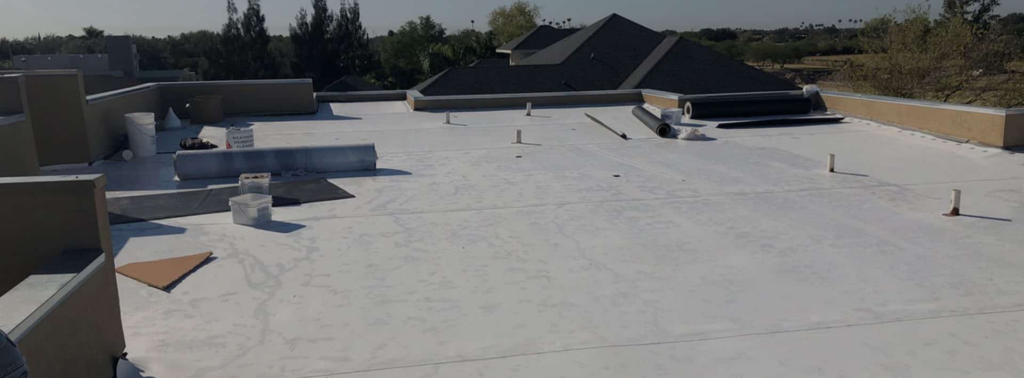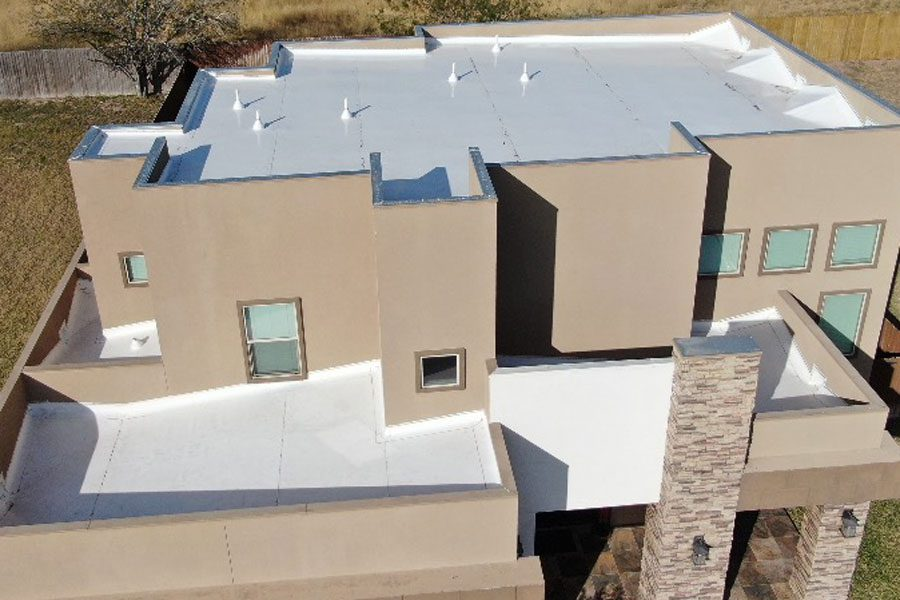Over the last twenty years, TPO (thermoplastic polyolefin) has emerged as one of the most widely used materials in the commercial roofing industry. TPO falls into the single-ply roofing category, made of flexible synthetic plastic sheets installed in a single layer.
TPO roofing now accounts for over 30% of low-slope commercial installations in North America. Property managers continually select TPO as their preferred flat roof covering.
What is TPO Roofing?
TPO roofing is a single-ply roof membrane made from flexible, heat-welded sheets of thermoplastic polyolefin material. TPO gets its name from that thermoplastic polyolefin composition. It offers a lightweight yet durable waterproof barrier popularly used on flat commercial roofs. But why is this material so popular?
TPO roofing offers the complete package – durability, energy efficiency, reliability and ease of install. Properly installed TPO roofing membrane can have a 30+ year lifespan. The reflective white surface also reduces cooling costs compared to darker roofs. Roof designers can customize thickness, color and layout specifications for new or retrofit projects with TPO. It checks off all the performance and budget items building owners want when investing in roofing systems.
Benefits of TPO Roofing
TPO has become the choice roofing membrane for so many building owners and property managers because of its many advantages over other commercial roofing materials. Here are some of the top benefits driving the popularity of TPO:
Durability
With proper installation following manufacturer guidelines, a general TPO membrane roof can expect a service life span of 20-30 years. High-quality raw materials and advanced production methods give TPO sheets superior tear and puncture resistance properties. This leads to excellent long-term durability compared to other roofing membranes.
Energy Efficiency
White thermoplastic polyolefin reflects sunlight extremely well thanks to its light color and smooth texture. This property enables TPO roofs to reduce air conditioning demand in warm climates. Studies show that white TPO roofs can decrease peak cooling demand by 10-30% versus dark roofs. This translates into substantial electricity and cost savings over time.
Low Maintenance
Unlike built-up roofs with gravel ballast or roof gardens, TPO requires little to no annual upkeep expenses. With proper initial installation, you can install it and “forget it” without heavy maintenance burdens for decades. TPO’s resilience against dirt buildup, mildew, splits and cracks minimizes manual rooftop interventions and operating costs.

What is a TPO Roof Made Of?
Thermoplastic Polyolefin Polymers
TPO consists of a blended composition of plastic and rubber polymers. This gives the materials both rigid and flexible properties important for roofing durability. It also enables heat welding for waterproof seams during installation.
Reinforcing Scrim
The TPO sheets contain an inner reinforcing layer of polyester or fiberglass mat. This adds tear strength and dimensional stability. It prevents small punctures from spreading across the membrane.
Recycled Plastics
Many TPO products incorporate up to 80% recycled plastic resins and fillers. This makes TPO an environmentally sustainable roofing choice.
UV and Fire Retardant Additives
Special chemical stabilizers protect against solar radiation damage and give fire resistance.
In summary, TPO roofing balances strength, flexibility, and durability through an innovative blend of polymers and reinforcements. Advanced additives enhance weatherability and conformance to roofing fire codes.
TPO Roofing Installation
Installing a reliable, watertight TPO roof system requires proper techniques and an experienced commercial roofing contractor. Here are some key aspects of properly installing TPO:
Seam Welding
Overlapping TPO sheets are fused together using automatic heat welding machines or handheld hot air guns. This chemically unites the thermoplastic polymers together into waterproof, monolithic seams stronger than the membrane itself.
Mechanical Fastening
The TPO membrane is secured to the roof deck using waterproof plates and screws along the seams. Specialty induction welding tools can also bind the membrane directly to steel roof decks without penetrations.
Fully Adhered Option
Some TPO systems are set in specialized adhesive rather than being mechanically fastened. This creates a strong chemical bond across the entire roof surface. It allows installation on surfaces unsuitable for mechanical attachment.
New Build vs. Retrofit
For new construction, TPO can be installed onto freshly poured concrete or above steel roof decking. On retrofits of existing buildings, the new TPO system can be adhered or mechanically fixed right over the old roof. This eliminates costly tear-off labor.
Proper installation techniques result in durable, monolithic TPO roofs that protect buildings for decades. Qualified commercial roofing contractors know all the methods to account for new build specifications or existing roof considerations.
Ideal Applications for TPO Roofs
TPO roofing membranes excel in certain building environments and roofing situations. Here are some of the best applications where TPO really shines:
Low-Slope & Flat Roofs
TPO sheets install best on flat or gently sloped commercial building roofs. The seams withstand ponding water well. TPO’s slip-resistance also minimizes safety hazards for foot traffic maintenance needs. Steep sloped roofs may instead require metal standing seam construction.
Large Surface Areas
TPO rolls cover wide areas quickly. The heat-welding process also facilitates quick seaming during installation. This makes TPO ideal for warehouses, manufacturing plants, shopping malls and other buildings with expansive flat roofscapes.
Stormy Climate Durability
TPO resists ponding water in any climate, as well as large temperature fluctuations. The thermoplastic and rubber polymers retain flexibility in both low and high temperatures, where other membranes may fail.
Retrofit/Re-Cover Projects
TPO roofing systems add minimal dead load when installed over an existing roof system. Mechanical fasteners make re-cover simple compared to full tear-off and replacement. This reduces landfill waste.
In summary, TPO delivers optimal performance longevity and value on low-slope commercial buildings across roof sizes and climates. The material lends itself well to both new construction and roof upgrades.
Comparing TPO to Other Roofing Materials
TPO has distinct advantages and disadvantages compared to other common commercial roofing products. Here is how TPO stacks up:
EPDM Rubber Roofing Materials
Like TPO, ethylene propylene diene rubber roofing (EPDM) is a single-ply system suitable for low slopes. It has an expected 50+ year service life but requires frequent coating renewal due to weathering. Seams are glued or taped rather than heat fused like TPO.
Modified Bitumen
Built-up “mod-bit” roofs involve installing alternating bitumen and reinforcement layers. These roofs last 15-25 years but involve more complex installation and maintenance. Mod-bit also handles ponding water poorly compared to seam-welded TPO.
Metal Roof Systems
Standing seam metal roofs have very long lifespans (50+ years) but at higher upfront costs. TPO roofing costs tend to be more affordable. Metal roofs also require additional considerations for snow load capacities and expansion/contraction allowances in their design.
Overall, TPO delivers an optimal balance of durability, sustainability, and installation ease/cost variables key for commercial roofing projects both large and small.
Why Choose XYZ Restorations for Your TPO Roof
If you’re considering TPO solutions for your commercial property, rely on the roofing contractors at XYZ Restorations for workmanship you can trust. XYZ provides full-service installation, maintenance, and repair of TPO systems from leading membrane brands.
RCAT Membership
XYZ Restorations meets the high business practice standards set by the Roofing Contractors Association of Texas. This demonstrates our commitment to professionalism and integrity.
Maintenance & Repairs
We don’t just install new TPO roofs, we also offer maintenance plans and service repairs of existing TPO systems regardless of original installer. This maximizes roof longevity.
For new roof construction or upgrading aging commercial buildings with TPO, trust in our years of experience and dedication to roof system quality and reliability.
Trust Your Building to the TPO Roofing Experts
TPO membrane is a superior commercial roofing material due to its durable seams, energy efficiency, low maintenance needs, and long lifespan of 20-30 years when properly installed. Servicing the McAllen TX area for years, XYZ Restorations has proprietary expertise in the specification, installation, and repair of advanced TPO roofing systems for any new or existing commercial facility. We offer complimentary consultations and competitive quotes; start by getting a free quote to extend the life of your building with thermoplastic polyolefin (TPO) roofing from the industry’s top rated contractors.

